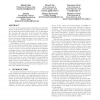Free Online Productivity Tools
i2Speak
i2Symbol
i2OCR
iTex2Img
iWeb2Print
iWeb2Shot
i2Type
iPdf2Split
iPdf2Merge
i2Bopomofo
i2Arabic
i2Style
i2Image
i2PDF
iLatex2Rtf
Sci2ools
RECSYS
2015
ACM
2015
ACM
Interaction Design in a Mobile Food Recommender System
One of the most important steps in building a recommender system is the interaction design process, which defines how the recommender system interacts with a user. It also shapes the experience the user gets, from the point she registers and provides her preferences to the system, to the point she receives recommendations generated by the system. A proper interaction design may improve user experience and hence may result in higher usability of the system, as well as, in higher satisfaction. In this paper, we focus on the interaction design of a mobile food recommender system that, through a novel interaction process, elicits users’ long-term and short-term preferences for recipes. User’s long-term preferences are captured by asking the user to rate and tag familiar recipes, while for collecting the short-term preferences, the user is asked to select the ingredients she would like to include in the recipe to be prepared. Based on the combined exploitation of both types of prefere...
| Added | 17 Apr 2016 |
| Updated | 17 Apr 2016 |
| Type | Journal |
| Year | 2015 |
| Where | RECSYS |
| Authors | Mehdi Elahi, Mouzhi Ge, Francesco Ricci, Ignacio Fernández-Tobías, Shlomo Berkovsky, David Massimo |
Comments (0)

